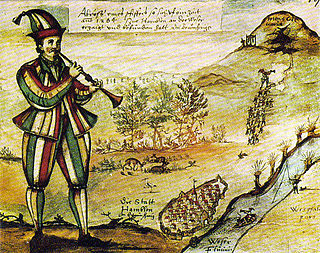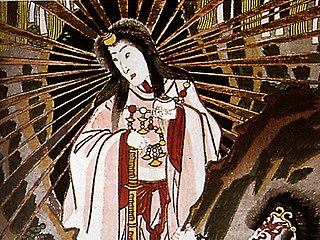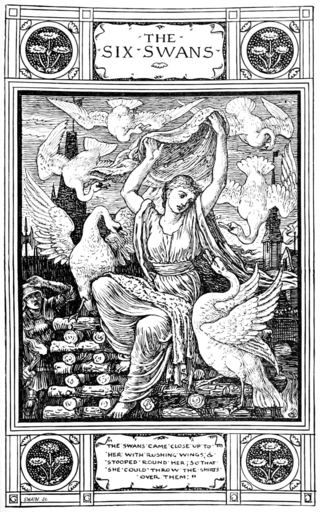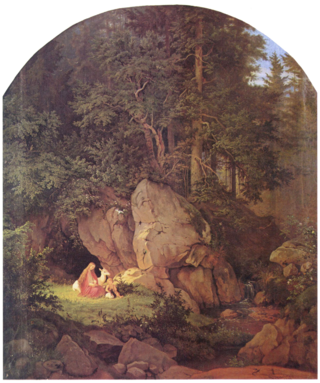Related Research Articles

The thunderbird is a legendary creature particular to North American indigenous peoples' history and culture. It is considered a supernatural being of power and strength.

The Pied Piper of Hamelin is the title character of a legend from the town of Hamelin (Hameln), Lower Saxony, Germany.
In Scandinavian folklore, the mylingar were the phantasmal incarnations of the souls of children that had been forced to roam the earth until they could persuade someone to bury them properly.

Tengu are a type of legendary creature found in Shinto belief. They are considered a type of yōkai or Shinto kami. The Tengu were originally thought to take the forms of birds of prey and a monkey deity, and they were traditionally depicted with human, monkey, and avian characteristics. Sarutahiko Ōkami is considered to be the original model of Konoha-Tengu, which today is widely considered the Tengu's defining characteristic in the popular imagination. He is the Shinto monkey deity who is said to shed light on Heaven and Earth. Some experts theorize that Sarutahiko was a sun god worshiped in the Ise region prior to the popularization of Amaterasu.
Redwall is a series of children's fantasy novels by British writer Brian Jacques, published from 1986 to 2011. It is also the title of the first book of the series, published in 1986, as well as the name of the abbey featured in the book, and is the name of an animated television series based on three of the novels, which first aired in 1999. The books are primarily aimed at adolescents. There have been 22 novels and two picture books published. The twenty-second, and final, novel, The Rogue Crew, was posthumously released on 3 May 2011, almost three months after Jacques' death on 5 February.

The bogeyman is a mythical creature used by adults to frighten children into good behaviour. Bogeymen have no specific appearances and conceptions vary drastically by household and culture, but they are most commonly depicted as masculine or androgynous monsters that punish children for misbehaviour. The bogeyman, and conceptually similar monsters can be found in many cultures around the world. Bogeymen may target a specific act or general misbehaviour, depending on the purpose of invoking the figure, often on the basis of a warning from an authority figure to a child. The term is sometimes used as a non-specific personification of, or metonym for, terror, and sometimes the Devil.

A hulder is a seductive forest creature found in Scandinavian folklore. Her name derives from a root meaning "covered" or "secret". In Norwegian folklore, she is known as huldra. She is known as the skogsrå "forest spirit" or Tallemaja "pine tree Mary" in Swedish folklore, and ulda in Sámi folklore. Her name suggests that she is originally the same being as the völva divine figure Huld and the German Holda.

The Nixie, Nixy, Nix, Näcken, Nicor, Nøkk, or Nøkken are humanoid, and often shapeshifting water spirits in Germanic mythology and folklore.

Raven Tales are the traditional human and animal creation stories of the indigenous peoples of the Pacific Northwest Coast. They are also found among Athabaskan-speaking peoples and others. Raven stories exist in nearly all of the First Nations throughout the region but are most prominent in the tales of the Haida, Tsimshian, Tlingit and Tahltan people.

The church grim is a guardian spirit in English and Nordic folklore that oversees the welfare of a particular Christian church, and protects the churchyard from those who would profane and commit sacrilege against it. It often appears as a black dog but is known to take the form of other animals. In modern times, when black dogs are kept as pets in churches and their attached parsonages, these are called church Grims since they reside on and guard ecclesiastical property.

"The Six Swans" is a German fairy tale collected by the Brothers Grimm in Grimm's Fairy Tales in 1812. It is of Aarne–Thompson type 451, commonly found throughout Europe. Other tales of this type include The Seven Ravens, The Twelve Wild Ducks, Udea and her Seven Brothers, The Wild Swans, and The Twelve Brothers. Andrew Lang included a variant of the tale in The Yellow Fairy Book.

Corvus is a widely distributed genus of passerine birds ranging from medium-sized to large-sized in the family Corvidae. It includes species commonly known as crows, ravens, and rooks. The species commonly encountered in Europe are the carrion crow, hooded crow, common raven, and rook; those discovered later were named "crow" or "raven" chiefly on the basis of their size, crows generally being smaller. The genus name is Latin for "raven".

Three crows are a symbol or metaphor in several traditions.

In folklore and fantasy, an enchanted forest is a forest under, or containing, enchantments. Such forests are described in the oldest folklore from regions where forests are common, and occur throughout the centuries to modern works of fantasy. They represent places unknown to the characters, and situations of liminality and transformation. The forest can feature as a place of threatening danger, or one of refuge, or a chance at adventure.

Many references to ravens exist in world lore and literature. Most depictions allude to the appearance and behavior of the wide-ranging common raven. Because of its black plumage, croaking call, and diet of carrion, the raven is often associated with loss and ill omen. Yet, its symbolism is complex. As a talking bird, the raven also represents prophecy and insight. Ravens in stories often act as psychopomps, connecting the material world with the world of spirits.

The Fox and the Crow is one of Aesop's Fables, numbered 124 in the Perry Index. There are early Latin and Greek versions and the fable may even have been portrayed on an ancient Greek vase. The story is used as a warning against listening to flattery.

Legends of vampires have existed for millennia; cultures such as the Mesopotamians, Hebrews, ancient Greeks, and Romans had tales of demonic entities and blood-drinking spirits which are considered precursors to modern vampires. Despite the occurrence of vampire-like creatures in these ancient civilizations, the folklore for the entity known today as the vampire originates almost exclusively from early 18th-century Central Europe, particularly Transylvania as verbal traditions of many ethnic groups of the region were recorded and published. In most cases, vampires are revenants of evil beings, suicide victims, or witches, but can also be created by a malevolent spirit possessing a corpse or a living person being bitten by a vampire themselves. Belief in such legends became so rife that in some areas it caused mass hysteria and even public executions of people believed to be vampires.

The rook is a member of the family Corvidae in the passerine order of birds. It is found in the Palearctic, its range extending from Scandinavia and western Europe to eastern Siberia. It is a large, gregarious, black-feathered bird, distinguished from similar species by the whitish featherless area on the face. Rooks nest collectively in the tops of tall trees, often close to farms or villages; the groups of nests are known as rookeries.

Malay folklore refers to a series of knowledge, traditions and taboos that have been passed down through many generations in oral, written and symbolic forms among the indigenous populations of Maritime Southeast Asia (Nusantara). They include among others, themes and subject matter related to the indigenous knowledge of the ethnic Malays and related ethnic groups within the region.
The Story of Princess Zeineb and King Leopard is a French language fairy tale published in the 18th century. The tale belongs to the international cycle of the Animal as Bridegroom as a subtype, with few variants reported across Europe. In it, the heroine is delivered to a cursed or enchanted prince, but breaks a taboo and loses him; later, she finds work elsewhere and wards off the unwanted advances of male suitors with the magical object her enchanted husband gave her.
References
- ↑ woerterbuchnetz.de
- ↑ Mackie, F. E. (September 2002). "Jamesian Notes & Queries: The Night-Raven". The Ghosts & Scholars M.R. James Newsletter. Retrieved 2024-06-17.
- ↑ "Year Walk Bedtime Stories for Awful Children". Simogo. 2015-09-02. Retrieved 2022-06-17.